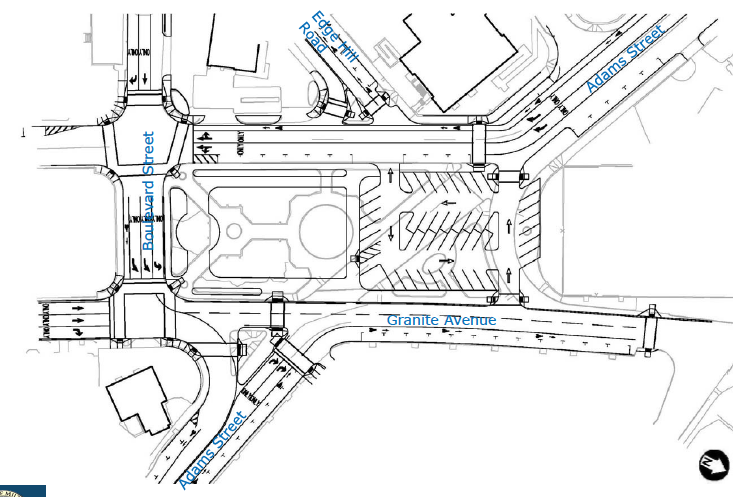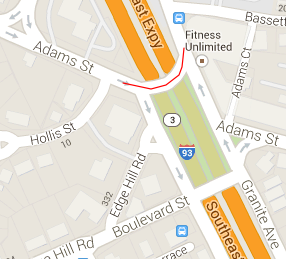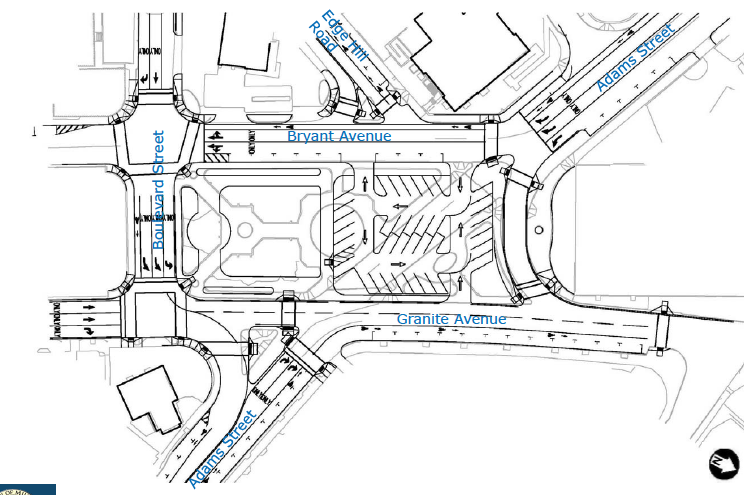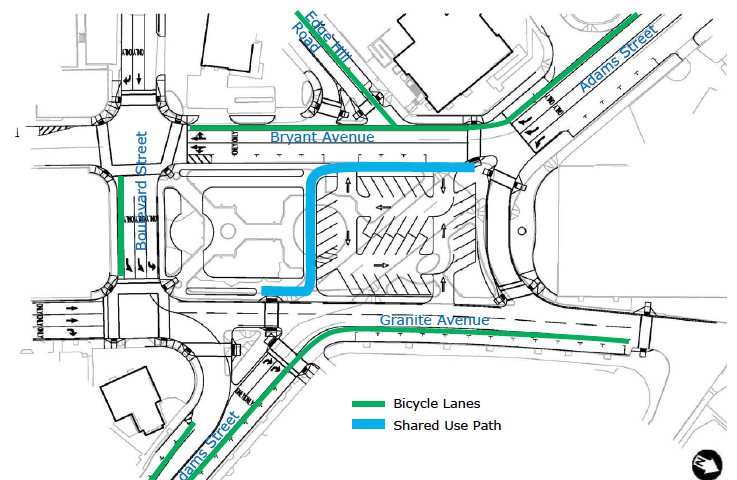by Frank Schroth
A public hearing was held on the East Milton Parking & Design project. The focus was on traffic. A key recommendation made by the consulting team, Howard/Stein-Hudson, is that the slip lane, which allows traffic flowing eastbound on Adams to turn north onto Granite Avenue, should stay.
The team, spearheaded by Nate Cabral-Curtis of of Howard Stein Hudson, had performed a traffic analysis study of the proposed change and concluded that the level of service at key traffic points (i.e. queuing of traffic and resulting wait times) would be negatively impacted. Second, the turn would be a difficult one for tractor trailer trucks which, if when at a red light, could cut across multiple lanes in making the turn across the expressway. They also said that the increased wait times could result in drivers attempting to use the new parking lot as a cut through.
Here are the two schematics that were presented, one with the slip lane and one without. Removing the slip lane would have the benefit of adding 8 additional parking spaces. There are 35 space in lot with slip lane and 43 in lot without it. (Note – the full presentation given is expected to be on the East Milton Design Study web site by end of day Monday 8/11).

Mr. Cabral Curtis was joined by HSH team members Alex Siu (traffic engineering) and Bridget Meyers (design). It was Ms. Siu who presented the traffic impacts that the loss of the slip lane would create. Those impacts are measured in terms of delay. Delay times are given a grade (e.g. 0-10 sec = A, 10 – 20 secs = B etc 35 – 55 = D, 55 to 80 secs = E and greater than 80 sec = F) Ms. Siu illustrated the impacts at all key traffic signals for both AM and PM. The number of points with wait times greater than 55 secs goes from 2 to 4 without the slip lane.
Ms. Meyers reviewed pedestrian and bicycle improvements. In the illustration below green lines indicate bike lanes and blue lines indicate a shared use path.
The next step will be a 25% complete hearing to be run by the Department of Transportation in the early fall. That will be followed by submittals from the design team at the 75% and 100% complete design phases. Public input will be solicited throughout the process.
Several residents spoke at the session. Town Meeting Member Cindy Christiansen asked if parking was the only option available for the space. Town Planner Bill Clark said it was as that is what the funding is for. Ms. Christiansen also asked if parking spaces on Bryant would be lost to the bicycle lane going in.
Ed Duffy, member of the Planning Board, also asked about the loss of spaces. In discussion with Clark it was acknowledged that 2 or 3 spaces would be lost to curb cuts for parking lot, not the bike lane.
Judith Gunderson asked several questions including whether or not the issue of the park had been resolved. The question being the availability of federal funds for a spot previously designated as a park. The response was yes. The park is being preserved. Ms. Gunderson also asked if the deck could support a lot that extended over the expressway. Again, the answer was affirmative.
Richard Wells, Chief of Police and chair of Traffic Commission, also spoke briefly. He spoke in favor of the decision to retain the slip lane saying it would reduce the likelihood of people cutting through the parking lot. He asked the team about a previously discussed option of putting angle parking on Edge Hill Road to alleviate parking congestion caused by folks visiting the post office. It was explained that funding does not support that but might be available if angle parking were designed for cars backing into the spots. This is viewed favorably by federal agencies due to safety. Children getting out of a vehicle that has backed into an angled spot have the car door between them and the road traffic.
In addition to retention of slip lane, the team identified improved abililty to time signalization of traffic lights as having a positive impact on traffic flow. Current signalization is managed by an outdated single switch. That switch will be replaced to allow the lights to be managed and timed in a more flexible manner.


